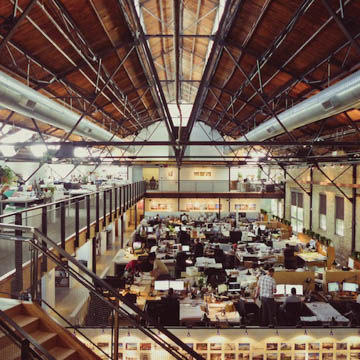The Bogue Supply Building in Salt Lake City houses up to seventy employees of one of Utah’s most successful architectural firms, FFKR Architects. The project showcases the collective values and design skills of FFKR, with the architect serving as her own client. The LEED-EB Silver–certified building represents the company’s attitude toward adaptive reuse, treading the line between fidelity to historic and aesthetic value of the original structure and contemporary standards of energy efficiency and functional space.
Located in what was once an active industrial area, the building was constructed in 1904 as a warehouse and foundry for Salt Lake Engineering Works. In 1930 Bogue Supply Company, which built, stored, and repaired customized mining machinery, took over the warehouse and occupied it until the business folded in 1998. The building’s suitability for adaptive reuse attracted FFKR Architects in 2001; among its admired features were the elegant high ceilings, strips of clerestory windows, the simple, long-span shed, and the rich volume of the steel skeleton. The architects have faith in the power of good design to restore abandoned and dilapidated areas to health again, and they believe in the resilience of attractive structures to adapt to new economic realities. FFKR spent a year retrofitting the warehouse into a chic office space with an expansive studio, a mezzanine, and conference and work rooms.
The building has been upgraded to meet seismic codes, was given a new roof in the spirit of the old one, and was gently washed brick by brick. Its life has been extended with cutting-edge additions and new technological improvements and yet, there are few visible signs of these interventions on the facade abutting the flyover of I-80 and the thoroughfare out of the city. Rising above street level, the ramps and overhead roads segment the view of the industries and accompanying amenities. This relationship between the building and the interstate is one that was repeated in many American cities during the second half of the twentieth century.
On the pale brick wall of the long exterior facing Fourth Street, the name Bogue Supply Company still appears in large painted letters that continue to function as a billboard to passing traffic; the building’s current occupant is indicated on small signs, square and red, that discreetly announce the name FFKR Architects on each of the three most visible facades, speaking to a very different cultural domain than the previous tenant. The entrance to the firm’s offices is reached through a parking lot and patch of xeriscaped landscape. Even the surface parking reflects an environmental ethos, with reserved spots for carpooling vehicles and bikes. Here, we are far away from the cavalier environmental and consumer attitudes of the mining industry of the twentieth century. The loading dock has also been reshaped into a minimalistic landscape ornamented with native plants and gravel, and what were previously considered weeds have now become much valued plants. A steel wheel and bridge rail crane have been moved from the interior and relocated on the exterior, and this defines FFKR’s approach to adaptive reuse: what were once primary elements of the previous life of the building have now become ornament.
This kind of inversion is on display throughout the site. Redundant machinery and now useless tools are exquisitely displayed in the interior. A new entryway distinguishes itself from the original with new materials, smooth textures, and precise detailing, and a grand staircase is placed asymmetrically and at an angle, greeting visitors to the warehouse, which is now full of people rather than machines. The original steel trusses of the building are exposed along the masonry walls, which have operable, refurbished single-pane windows. The building meets energy-efficiency and thermal-insulation standards through this natural ventilation as well as a robust suite of solar panels on the roof. Emboldened by the unpretentiousness of the original warehouse, new interventions display their features proudly, too. The floor of the mezzanine does not hide but flaunts the unpolished, untreated I-joists. The structure uses the most refined techniques to partake in the raw and unrefined language of industrial design. Shiny mechanical ductwork and elemental light fixtures recreate the industrial “feel.” But what was previously a warehouse now becomes a grand hall, and what was previously infrastructure now becomes a work of art in almost Ruskinian terms: the “spirit which is given only by the hand and eye of the workman, can never be recalled. Another spirit may be given by another time, and it is then a new building.”
As a meditation on controlling time and decay, this preservation project has at its heart a conversation about the “age value” implicit in the warehouse and how, through the mildest of emotional appeal it became a work of “artistic value.” FFKR Architects has turned a facility concerned first and foremost with practical values into a monument. The story Bogue Supply Building tells is not of a glorious monument well maintained but rather of the ordinary industrial vernacular fabric turned extraordinary by restoration.
References
“Bogue Supply Company Building, Salt Lake City.” Utah Heritage Foundation. Accessed April 23, 2014. https://preservationutah.org/.
“Bogue Supply Building Adaptice Re-Use, Salt Lake City, Utah.” FFKR Architects. Accessed April 23, 2014. https://www.ffkr.com/.
“Historic Bogue Warehouse Transformed into Outstanding Solar Powered Offices in Salt Lake City.” Inhabitat. Accessed April 20, 2014. https://inhabitat.com/.














